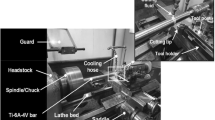Abstract
This paper presents an experimental machining study of turning medium carbon alloy steel 4140 on Haas CNC turning center with TiC/TiCN/TiN-coated carbide inserts under different lubricating conditions. Cutting speed and feed rate were controlled at three different levels while a constant depth of cut is employed throughout the entire experimental study. The cutting fluid used in the study was produced from a genetically modified soybean oil and is hence biodegradable, renewable, less toxic, and sustainable to the environment. The three lubricating conditions tested in the study were dry, minimum quantity lubrication (MQL) (40 mL/min), and flood (1.3 L/min) conditions. With cutting speed and feed rate being control variables and cutting lubricate condition as noise factor, in total, 27 experimental runs were conducted according to Taguchi’s L9 (34) orthogonal array. Statistical analysis using one-way ANOVA found that feed rate is a significant factor impacting surface roughness while cutting speed does not impact tool wear due to the range of speeds selected and use of coated insert. This study also concludes that dry condition generates the best result as the applications of cutting fluid in flood or MQL format did not generate significantly better surface roughness and lower tool wear. This implies that cutting fluids may be eliminated with careful selection of cutting parameters and tooling materials.







Similar content being viewed by others
References
Byers JP (ed) (2006) Metalworking fluids, 2nd edn. CRC Press, Boca Raton
Su Y, Gong L, Li B, Liu Z, Chen D (2016) Performance evaluation of nanofluid MQL with vegetable-based oil and ester oil as base fluids in turning. Int J Adv Manuf Technol 83(9–12):2083–2089
Cakir O, Yardimeden A, Ozben T, Kilickap E (2007). Selection of cutting fluids in machining processes, 21280 Diyarbakir, Turkey, 2007
Rao DN, Srikant RR (2006) Influence of emulsifier content on cutting fluid properties. Proc Inst Mech Eng B J Eng Manuf 220:1803–1806
Shashidhara YM, Jayaram SR (2010) Vegetable oils as a potential cutting fluid-an evolution. Tribol Int 43(5–6):1073–1081
Iowa Waste Reduction Center (2003) Cutting fluid management: small machining operations. a practical pollution prevention guide, 3rd edn. University of Northern Iowa
Lawal SA, Choudhury IA, Nukman Y (2012) Application of vegetable oil-based metalworking fluids in machining ferrous metals – a review. Int J Mach Tool Manuf 52(1):1–12
Zhang J, Rao PN, Eckman M (2012) Evaluation of a bio-based cutting fluid using multiple machining characteristics. Int J Mod Eng 12(2):35–44
Revuru RS, Zhang J, Rao PN (2018) Optimization of titanium alloys turning operations in varied cutting fluid conditions with multiple machining performance characteristics. Int J Adv Manuf Technol 95:1420–1463
Rao PN, Zhang J, Eckman M (2013) Experimental study and regression modeling of tool wear in CNC turning operation using soybean based cutting fluid. J Mech Eng 10(1):85–102
Sharma J, Sidhu BS (2014) Investigation of effects of dry and near dry machining on AISI D2 steel using vegetable oil. J Clean Prod 66:619–623
Prasad KV, Kashyap KT, Richard MJ, Rao PGP, Rajole A, Hiren R (2017) Grey relational optimization of turning parameters in dry machining of austenitic stainless steel using Zr based coated tools. Open J Appl Sci 7:337–347
Pervaiz S, Samad WA (2018) Tool Wear mechanisms of physical vapor deposition (PVD) TiAlN coated tools under vegetable oil based lubrication. In: Mechanics of Additive and Advanced Manufacturing, vol 9, pp 101–107
Krolczyk GM, Nieslony P, Maruda RW, Wojciechowski S (2017) Dry cutting effect in turning of a duplex stainless steel as a key factor in clean production. J Clean Prod 142:3343–3354
Abhang LB, Hameedullah H (2012) Optimization of machining parameters in steel turning operation by Taguchi method. Procedia Eng 38:40–48
Motorcu AR (2010) The optimization of machining parameters using the Taguchi method for surface roughness of AISI 8660 hardened alloy steel. J Mech Eng 56(6):391–401
Selvaraj DP, Chandramohan P, Mohanraj M (2014) Optimization of surface roughness, cutting force and tool wear of nitrogen alloyed duplex stainless steel in a dry turning process using Taguchi method. Measurement 49:205–215
Khake, R., Kadam, S., Chavan, V., & Sadaiah, M. (2016). Experimental investigations on surface roughness, cutting forces and tool wear in the turning of super duplex stainless steel with PVD coated carbide inserts. Proceedings of 6thInternational & 27thAll India Manufacturing Technology, Design and Research Conference (AIMTDR-2016). College of Engineering, Pune, Maharashtra, India, December 16-18, 2016
Revankar GD, Shetty R, Rao SS, Gaitonde VN (2014) Analysis of surface roughness and hardness in titanium alloy machining with polycrystalline diamond tool under different lubricating modes. Mater Res 4(17):1010–1022
Boing D, De Oliveira AJ, Schroeter RB (2020) Evaluation of wear mechanisms of PVD and CVD coatings deposited on cemented carbide substrates applied to hard turning. Int J Adv Manuf Technol 106(11):5441–5451
Jayal AD, Balaji AK (2009) Effects of cutting fluid application on tool wear in machining: interactions with tool-coatings and tool surface features. Wear 267(9–10):1723–1730
Goindi GS, Sarkar P (2017) Dry machining: a step towards sustainable machining- challenges and future directions. J Clean Prod 165(2017):1557–1571
Lawal SA, Choudhury IA, Nukman Y (2015) Experimental evaluation and optimization of flank wear during turning of AISI 4340 steel with coated carbide inserts using different cutting fluids. J Inst Eng (India) Series C 96(1):21–28
Funding
This research was financially supported by the Capacity Building Project funded by the Office of the Vice-President and Provost, University of Northern Iowa.
Author information
Authors and Affiliations
Corresponding author
Additional information
Publisher’s note
Springer Nature remains neutral with regard to jurisdictional claims in published maps and institutional affiliations.
Rights and permissions
About this article
Cite this article
Revuru, R.S., Zhang, J.Z. & Posinasetti, N.R. Comparative performance studies of turning 4140 steel with TiC/TiCN/TiN-coated carbide inserts using MQL, flooding with vegetable cutting fluids, and dry machining. Int J Adv Manuf Technol 108, 381–391 (2020). https://doi.org/10.1007/s00170-020-05378-8
Received:
Accepted:
Published:
Issue Date:
DOI: https://doi.org/10.1007/s00170-020-05378-8




